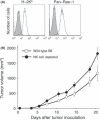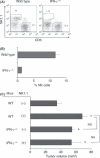Early activation and interferon-γ production of tumor-infiltrating mature CD27 high natural killer cells
- PMID: 21781225
- PMCID: PMC11158882
- DOI: 10.1111/j.1349-7006.2011.02042.x
Early activation and interferon-γ production of tumor-infiltrating mature CD27 high natural killer cells
Abstract
Natural killer (NK) cells are known to be critically involved in the control of tumors through their direct cytotoxic function, but have also been proposed as an initial source of interferon (IFN)-γ that primes subsequent adaptive tumor-specific immune responses. Although mounting evidence supports the importance of NK cells in antitumor immune responses, the immunological characteristics of NK cells infiltrating the tumor microenvironment and the mechanisms that regulate this process remain unclear. In the present study, we found that NK cells infiltrate early developing MCA205 tumors, and further showed that mature CD27(high) NK cells were the predominant subpopulation of NK cells accumulating in the tumor microenvironment. The tumor-infiltrating NK cells displayed an activated cell surface phenotype and provided an early source of IFN-γ. Importantly, we also found that host IFN-γ was critical for NK cell infiltration into the local tumor site and that the tumor-infiltrating NK cells mainly suppressed tumor growth via the IFN-γ pathway. This work implicates the importance of IFN-γ as a positive regulatory factor for NK cell recruitment into the tumor microenvironment and an effective antitumor immune effector response.
© 2011 Japanese Cancer Association.
Figures





Similar articles
-
Early-appearing tumor-infiltrating natural killer cells play an important role in the nitric oxide production of tumor-associated macrophages through their interferon production.Cancer Immunol Immunother. 1998 Jan;45(5):225-33. doi: 10.1007/s002620050437. Cancer Immunol Immunother. 1998. PMID: 9439645 Free PMC article.
-
Differential modulating effect of natural killer (NK) T cells on interferon-γ production and cytotoxic function of NK cells and its relationship with NK subsets in Chlamydia muridarum infection.Immunology. 2011 Oct;134(2):172-84. doi: 10.1111/j.1365-2567.2011.03477.x. Immunology. 2011. PMID: 21896012 Free PMC article.
-
CD70 reverse signaling enhances NK cell function and immunosurveillance in CD27-expressing B-cell malignancies.Blood. 2017 Jul 20;130(3):297-309. doi: 10.1182/blood-2016-12-756585. Epub 2017 May 11. Blood. 2017. PMID: 28495792
-
Metabolic Regulation of Natural Killer Cell IFN-γ Production.Crit Rev Immunol. 2016;36(2):131-147. doi: 10.1615/CritRevImmunol.2016017387. Crit Rev Immunol. 2016. PMID: 27910764 Free PMC article. Review.
-
Tumor Microenvironment-Associated Extracellular Matrix Components Regulate NK Cell Function.Front Immunol. 2020 Jan 29;11:73. doi: 10.3389/fimmu.2020.00073. eCollection 2020. Front Immunol. 2020. PMID: 32063906 Free PMC article. Review.
Cited by
-
CD11b(-)CD27(-) NK cells are associated with the progression of lung carcinoma.PLoS One. 2013;8(4):e61024. doi: 10.1371/journal.pone.0061024. Epub 2013 Apr 2. PLoS One. 2013. PMID: 23565296 Free PMC article.
-
Lung-resident natural killer cells control pulmonary tumor growth in mice.Cancer Sci. 2018 Sep;109(9):2670-2676. doi: 10.1111/cas.13703. Epub 2018 Jul 12. Cancer Sci. 2018. PMID: 29927042 Free PMC article.
-
Increased B7-H4 expression during esophageal squamous cell carcinogenesis is associated with IL-6/STAT3 signaling pathway activation in mice.Oncol Lett. 2017 Apr;13(4):2207-2215. doi: 10.3892/ol.2017.5688. Epub 2017 Feb 7. Oncol Lett. 2017. PMID: 28454382 Free PMC article.
-
Key features and homing properties of NK cells in the liver are shaped by activated iNKT cells.Sci Rep. 2019 Nov 8;9(1):16362. doi: 10.1038/s41598-019-52666-9. Sci Rep. 2019. PMID: 31704965 Free PMC article.
-
KLRG1+ natural killer cells protect against pulmonary metastatic disease by immunosurveillance.Oncoimmunology. 2014 Apr 8;3:e28328. doi: 10.4161/onci.28328. eCollection 2014. Oncoimmunology. 2014. PMID: 25050205 Free PMC article.
References
-
- Mueller MM, Fusenig NE. Friends or foes – bipolar effects of the tumour stroma in cancer. Nat Rev Cancer 2004; 4: 839–49. - PubMed
-
- Albini A, Sporn MB. The tumour microenvironment as a target for chemoprevention. Nat Rev Cancer 2007; 7: 139–47. - PubMed
-
- Smyth MJ, Hayakawa Y, Takeda K, Yagita H. New aspects of natural‐killer‐cell surveillance and therapy of cancer. Nat Rev Cancer 2002; 2: 850–61. - PubMed
-
- Lanier LL. NK cell recognition. Annu Rev Immunol 2005; 23: 225–74. - PubMed
Publication types
MeSH terms
Substances
LinkOut - more resources
Full Text Sources
Molecular Biology Databases
Research Materials

